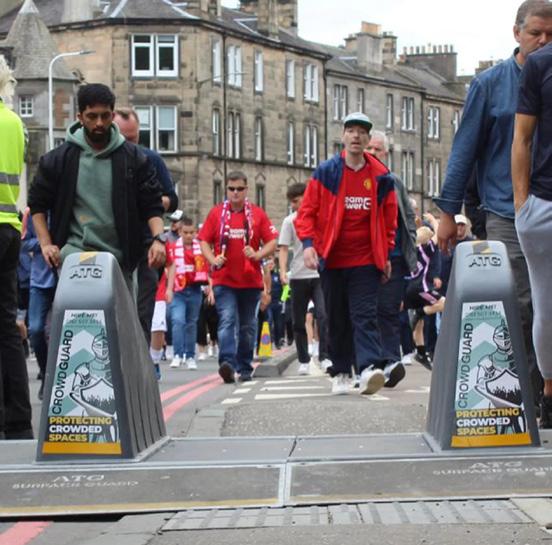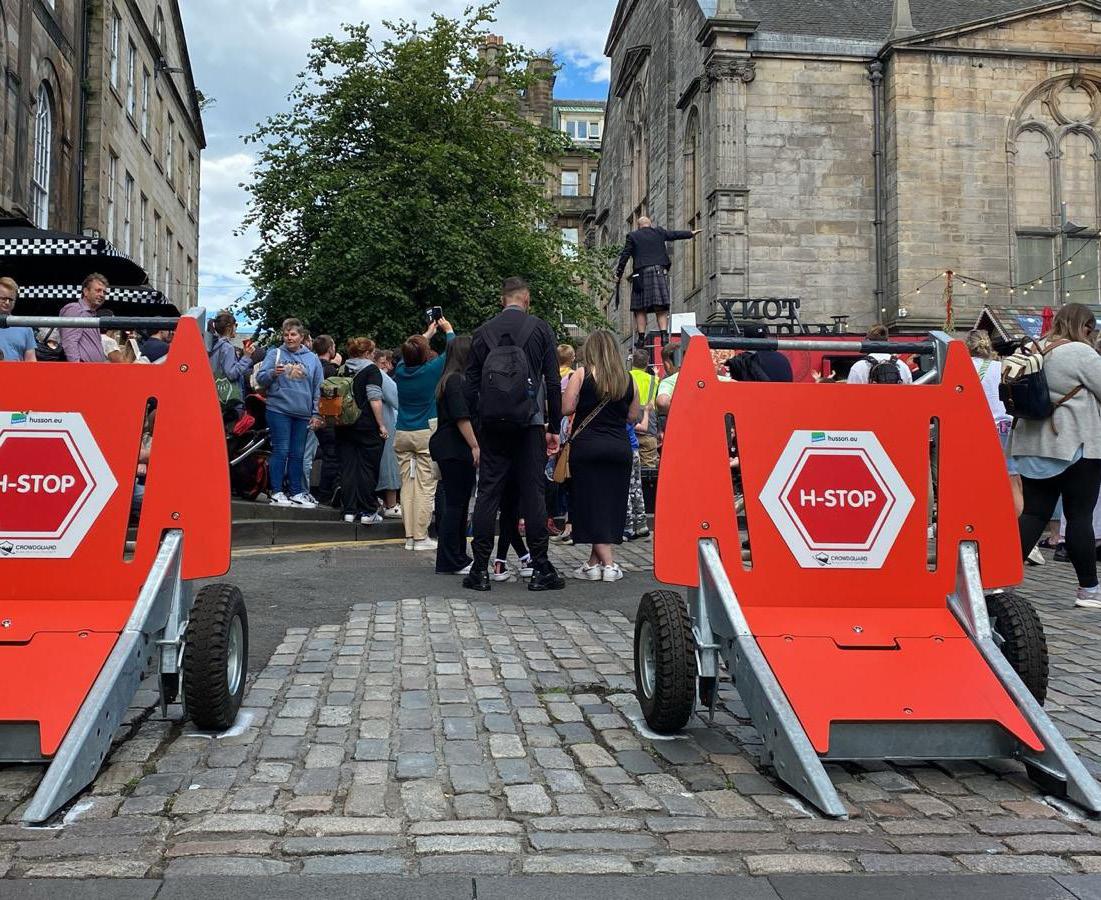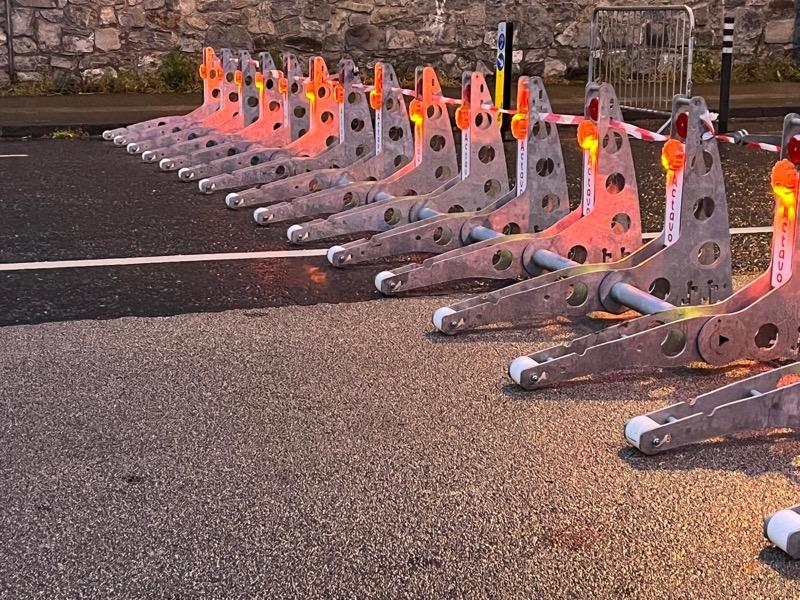

Understanding HVM for events.
This handout is designed as a follow up to the webinar presented recently by Crowdguard.

PLAN . PROVIDE . PROTECT
Who are Crowdguard.

Crowdguard are a specialist in event safety and crowd management.
We are a specialist in event safety and crowd management. We provide a turnkey service to help you plan and implement strategies to keep people safer with marketleading solutions, installed by experts, and designed to help you mitigate risk.
Our
Aim
Our aim is to support and advise you by offering a flexible approach to helping you understand your risk and select physical protection systems aligned to your risk factors, your operational requirement, and your budget.
We can advise you from our broad portfolio of tested and certified HVM and barrier systems.
Every installation is specified, managed and quality assured by us, including deployment of trained and trusted installation teams anywhere in the UK, and a full derigging service, to your required schedule.
We are proud members of the Perimeter Protection Suppliers Association (PSSA) and work with a variety of industry partners to provide a turnkey service, from risk assessment through to deployment.






What is Hostile Vehicle Mitigation?
Hostile
Vehicle Mitigation (HVM) barriers protect people and property from vehicle attacks and unauthorized entry.from being used as weapons and to prevent unauthorised vehicles from entering secure areas.
Hostile Vehicle
Mitigation (HVM) is a protective security discipline focussing on reducing risks associated with vehicle borne threats posed by terrorists and criminals.
HVM is the delivery of measures that are informed by the threat and how it manifests
itself, the multiple consequences of an attack, the vulnerability of a given location and the needs of the enterprise requiring protection.
The basis of HVM are security risk assessments, security planning, and design and the deployment of risk-based measures.
There are many different options for your hostile vehicle mitigation barriers, and often a number of different systems are deployed in a single security installation.
One of the key factors to consider is whether you need temporary HVM, a semi-permanent hostile vehicle mitigation system or permanent HVM protection.
Crowdguard . HVM for Events
www.crowdguard.co.uk

What are HVM Measures?
HVM measures are the integrated deployment of security processes, procedures and physical obstructions to counter vehicle borne threats.
They typically include;
Deterrent communications, security awareness, incident response planning and training, operational security, traffic management and the deployment of physical obstructions such as vehicle security barriers and traffic calming measures.
For advice on deterrent communications go to; www.npsa.gov.uk/security-mindedcommunications-guidance
For advice on security awareness, incident response planning and training go to the following; www.protectuk.police.uk/catalogue www.npsa.gov.uk
For advice on vehicle security barriers and specific help for your event go to; www.crowdguard.co.uk



ENCROACHMENT
Exploiting gaps in defences or tailgating


DURESS
Using a trojan vehicle
Against a guard to open a barrier or deliver an explosive
PENETRATIVE

TAMPER / SABOTAGE
Consider which of these may be relevant to your event.
Crowdguard . HVM for Events
www.crowdguard.co.uk
Vulnerability of Locations.


Approach roads
Are they long and straight or narrow and winding?

Queue
Where people may queue to get in?

Staffing
Number of staff on duty – and their posture.
Duration of the event
Could a hostile attend & plan an attack in the preceding days?

Routes
Routes people might take to leave to go home.

Processes
Gates or processes to enter the venue or event location.
Deployment of Risk Based Measures
It is essential that when you deploy any measures they are based on a risk assessment and form part of an overarching Counter Terrorism (CT) plan.
Your CT plan may well sit as part of your security plan, but all methods of attack should be considered.
What may be appropriate for one event may not be appropriate for a different event in the same location or the same event in a different location.
Take for example a craft fair in a town square, would you need to consider vehicle security barriers for this event?
However, take the same square but the event is now a high profile visit by the king who has decided he would like to walk around and shake hands with as many serving military personnel as possible.

Measures to Consider.

Deter
Stop or displace the attack.

Mitigate
Minimise the consequences of an attack.

Detect
Verify an attack and initiate the response.

Respond
Actions to prevent the goal of the attack being completed.


Delay
Maximise the delay through the use of approved security.

Examples
Examples include but are not limited to (following page)
Crowdguard . HVM for Events www.crowdguard.co.uk


Detect
Staff trained on Action Counter Terrorism, appropriate C3 processes, vehicle access passes, CCTV, etc.
Deter
Security minded communications in advance of the event. Security teams on duty during the build phase, etc.



Respond
Consider the use of RAPAID or other trauma kits that could be used to save lives. Medical provision on site. ACT awareness and the use of RUN / HIDE / TEL – communicate with others in the area.
Mitigate
Consider the use of RAPAID or other trauma kits that could be used to save lives. Medical provision on site. ACT awareness and the use of RUN / HIDE / TELL. Communication with others in the area.

Delay
Appropriately designed HVM scheme and plan with rated vehicle security barriers. The scheme could include measures designed to slow approaching vehicles, such as chicanes, access control, etc.
HVM Plan
It is crucial that the HVM plan considers all aspects of the event management plan and is flexible and proportionate enough to be considered appropriate whilst not being onerous.
Security processes.
The security processes and procedures that could be used, as part of the HVM scheme, are not set in stone.
The number and types of layers required and considered appropriate
and proportionate will be deemed by the risk assessment. These layers all work together to ensure that even if a hostile actor goes undetected at one, there is a possibility that they will be discovered or deterred by the next.

Layers of Security
• Behavioural detection officers
• ANPR Systems linked to the appropriate databases.
• Agreed process for opening and closing of barriers
• Vehicle access pass – to ensure only authorised vehicles allowed access
• Soft measures to increase stand-off
• Chicanes to slow approach speed
• Armed police
• Vehicle search process – even authorised vehicles may be compromised.
• Onsite vehicle movement plan
• Highly visible security teams
• Tactical parking of vehicles
• Traffic management plan
• Security minded comms
• Flexibility – all of the plan may not be needed all of the time
• Rated vehicle security barriers –please see Crowdguard
• ACT training for all staff
• Onsite key management
Physical Obstructions.
Consider what is already at your location and utilise it if you possibly can. Any ground that is not traversable by a vehicle can be considered to reduce the risk.

Physical Obstructions
Changes in elevation, steep steps, banks, bunds or bodies of water can all be used to reduce the risk. They may not remove it as the capabilities of modern vehicles can be high but understanding that some physical obstructions might reduce the risk will help with the planning.
Permanent or semi-permanent rated vehicle security barriers give the best levels of protection and their reaction to attack is known.
Counter Terrorism Plan
It is important to remember that even with a full deployment of rated vehicle security barriers there is a chance that an attack will still take place.
It is likely that the barrier location is where the attack will start. It may then lead into a marauding or layered attack using other methodologies such as, improvised explosive devices (IED’s), firearms, knives or bladed weapons, fire as a weapon or others.
Your CT plan must consider ways to reduce the threat from and mitigate the impact of these and other methods of attack.
A fully deployed set of vehicle security barriers will still only DELAY an attack and give you time for a response or reaction. It is crucial that this time is maximised by the implementation of a well prepared plan.
www.crowdguard.co.uk
Comprehensive Support.
Questions
We at Crowdguard are here to help you with any questions you may have. The options discussed here are just some of the things you may wish to consider; There are many others.
Magna Aliquam
Crowdguard’s PLAN, PROVIDE, PROTECT model means that we are in a position to ensure that you get all of the assistance you require to ensure that your event goes as smoothly as possible. Our holistic approach around Risk Assessment, Specification and Deployment ensures you get the service you need suited to your own unique circumstances.
For more information contact us at info@crowdguard.co.uk

Crowdguard . HVM for Events www.crowdguard.co.uk
Impact Tested
Vehicle Security Barriers.
Vehicle Security Barriers, or VSB’s are a physical measure that is placed at a location to prevent vehicles from being able to enter without being authorised.
They come in many shapes and sizes, but it is strongly advised that any that you choose carry an authorised rating. This means they have been tested by an official test house and been given a rating which means that it is understood how a product will perform in a certain set of circumstances.
The best way to check if a product you are offered has been tested and rated is to see if it is currently in the NPSA Catalogue of Security Equipment.
This can be checked here. www.npsa.gov.uk/ cse-categories – All of Crowdguard’s products are in the catalogue.
There are two types of tested products listed in the catalogue; Impact Tested and Delay Rated.
These products will carry a rating under one of the following standards;
ISO 22343 . PAS 68 IWA14-1

These products will have had vehicles of known mass and type driven into them at known speeds.
Delay Rated
A delay rated product will have been tested under the Vehicle Attack Delay Standard (also known as VADS).





Crowdguard . HVM for Events
www.crowdguard.co.uk
Our Products
The following table is a selection of some of the products currently in the Crowdguard portfolio.
We are constantly working with the whole range of suppliers across the industry and regularly add to our stock as new products become available. Products are regularly changing their specifications too as they get tested in different scenarios and formations. It is strongly recommended to check our website for the latest equipment we have.
www.crowdguard.co.uk
Crowdguard understands that one size does not fit all.
This is the reason why we have such a wide range of equipment available to us. Your operational requirement is important to us, and we will strive to achieve your needs with our product recommendations.
Our team has years of experience in assessing requirements and designing appropriate and proportionate VSB schemes.

Husson H-Stop
Rating: ISO22343-1V/3500/48/90:12.9/19.0
Comments:
• Quick and easy installation
• Immediate authorised vehicle access; can be wheeled away easily.
• 1200mm pedestrian permeability between each unit.
• Suitable for uneven road surfaces.
• Advertising, branding and wayfinding opportunities.
• Compact storage.
• Single unit certified to stop 3500kg vehicle at 48kph with <13m penetration.


ATG Surface Guard
Rating: IWA14-1 V/7200/32/90:4.8 + VADS
Comments:
• Fast to install.
• Fully pedestrian permeable.
• Can allow emergency vehicle access within around 30 seconds.
• Fully surface mounted.
• Aesthetically pleasing and can be branded.
• Will manage kerbs, islands etc.
• Can be deployed longer term if required.
RB-50
Rating: IWA14-1 V7200 48/90:25.5
Comments:
• Quick and easy installation.
• Immediate authorised vehicle access; can be wheeled away easily.
• Fully surface mounted.
• Deployed in 4m arrays.
• Easy to transport.
Crowdguard . HVM for Events www.crowdguard.co.uk

ARX Stopper! ™
Rating: PAS68 V/7500/48/90:20.7/0.0 +VADS
Comments:
• Quick and easy installation.
• 1200mm pedestrian permeability between each unit.
• Suitable for uneven road surfaces.
• Advertising, branding and wayfinding opportunities.
• Can be impact or VADS deployed depending on requirement.

The Claw
Rating: IWA14-1 V/7200/32/90:1.2 + VADS
Comments:
• Drop and go deployment.
• Tamper resistant.
• Surface mounted.
• 1200mm pedestrian permeability between each unit.
• Customisation options for bins, cycle racks etc.
• Advertising, branding and wayfinding opportunities.

Armis One
Rating: ISO22343-1V/7200/48/90:8.3/0.0
Comments:
• Quick and easy installation with ramps.
• Immediate authorised vehicle access; can be lowered quickly.
• 1200mm pedestrian permeability between each unit.
• Suitable for uneven road surfaces.
• Tamper proof. No need to guard when not in use.
• Drive over up to 40 tons.
• Non-slip surface.

Unafor – The Core (Semi-Permanent system)
Rating: IWA14-1 V/3500/48/90:2.8
Comments:
• Semi-permanent solution that requires installation below surface of around 200mm.
• Bollards or other equipment, (bins, seats etc) can be removed when not required. Ideally suited for areas where repeat events are held, stadiums, town squares etc.
• Can also be used for shopfront protection against ram raids etc.



